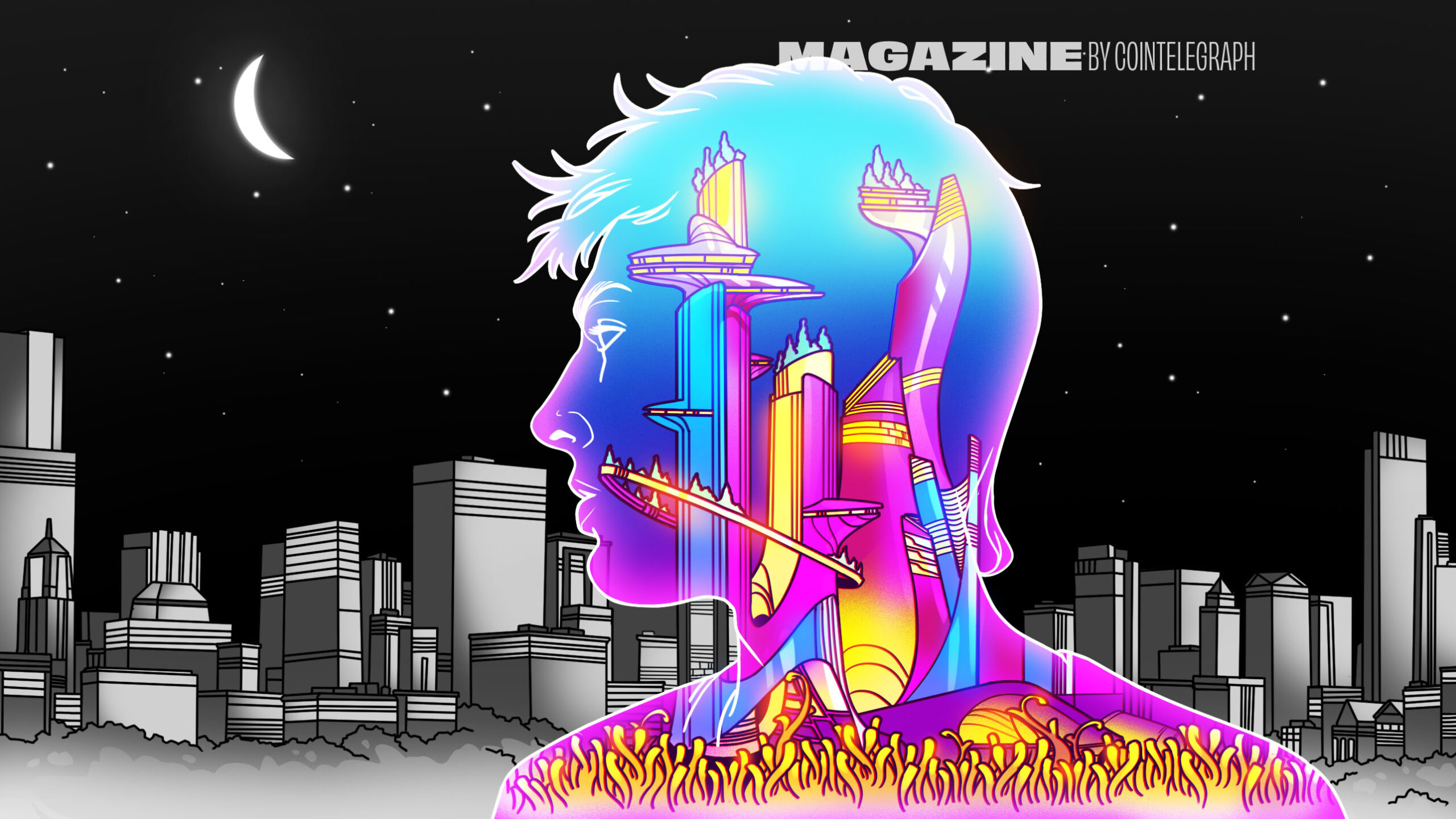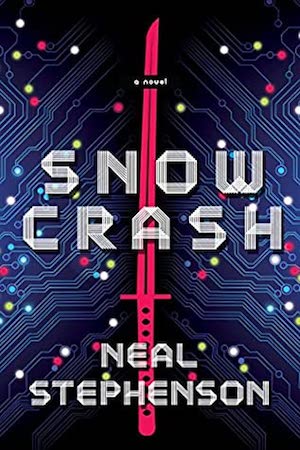Is the Metaverse really turning out like ‘Snow Crash’? – Cointelegraph Magazine

[ad_1]

Neal Stephenson’s science fiction novel Snow Crash predicted the Metaverse in 1992. This cult book has the amusingly-named Hiro Protagonist running around in an artificial cyber world, trying to stop a virus that wipes minds, aided by his hacker friend Y.T. Reality is a place to escape from, a neoliberal future wrecked by hyperinflation and inequality and run by corporations and gangsters and insane bureaucracy.
In many ways, the book is horribly prescient. (It’s also horribly written in places, more like an info dump than a novel.) The Metaverse was a place where people had digital avatars, where they hung out with friends, went shopping and attended concerts. It was full of ads, the infrastructure was owned by a billionaire, and a virus was wreaking havoc on society. It all sounds familiar.
It wasn’t COVID-19 of course. The Snow Crash virus caused the infected to lose the ability to think for themselves, and they start speaking in tongues.
“Obviously, at the time, we didn’t have social media,” Stephenson told The Washington Post, but added, “I was writing about just a long-standing human trait, which is this tendency for the mind to get hijacked by ideas.”
The metaverse can’t enslave you, yet, but the addictive nature of social media suggests it’s possible you might get hooked on a better virtual world, where your hotter-looking avatar interacts with people from all over the planet and has adventures that are not possible in reality.

To give you one crazy example of the possibilities, there is an actual theater company in the zombie-infested online wasteland survival game Fallout 76 that puts on Shakespeare plays. So, you can be part of the audience, or even audition and act, if you desire. Almost normal, except you may have to blast a few zombies in the middle of Romeo and Juliet. The ushers patrol the perimeter with chainsaws and AK-47s to annihilate any undead critics seeking to make their analytical discourse upon the performance.
This is all very Snow Crash. There is a real tension between the use of virtual worlds for escape or leisure and the impetus for profiteering. Many corporations see the metaverse and metaverse platforms as new continents to be colonized and exploited. If the metaverse develops under a centralized model, then it will be Amazon, Facebook and Google all over again: whale time. A decentralized metaverse built around blockchain technology would be more egalitarian and put the power back in the hands of users.
Enter the metaverse, stage left

Dr. Christina Yan Zhang, nicknamed “Dr. Metaverse,” wrote her 2012 thesis about MMORPGs and the early metaverse platform Second Life, so she’s been thinking about this longer than most. She’s now the CEO of the Metaverse Institute.
“I think the beauty about the current development of the metaverse is basically the convergence of a whole range of different technologies coming together. Many of them are getting more advanced to really help to create the next generation of internet, which is more immersive, interactive and intuitive.”
She sees the metaverse as an enabling technology to improve interaction in both real and digital worlds.
Gaming writer Wagner James Au has just finished a book that will be published in June titled Making a Metaverse That Matters. Back in the early 2000s, he was the “virtual journalist named Hamlet” in Second Life. His white-suited avatar (a nod to Tom Wolfe) went around submitting dispatches from that virtual world.
He envisions there being multiple metaverses: “It’s going to be based on the community; it’s going to be based on culture and aesthetics. For example, Roblox is huge, but it’s primarily with kids. And the aesthetics are very intentionally looking like Legos. You could jump from Roblox to Fortnite, then Fortnite to VR chat. So, it will not be a single, virtual world.”

He continues, “I define it very directly from what Snow Crash described: It was a vast virtual world with user creation tools and highly customizable avatars that is integrated with the real world economy.”
“In other words, you can make money from it and also integrate with external technology so you can actually hook it up to other technology beyond the immersive 3D experience.”
Read also
Features
Shanghai Special: Crypto crackdown fallout and what happens next
Features
Cleaning up crypto: How much enforcement is too much?
Snow Crash and capitalist realism
Science fiction and fantasy are known for creating new worlds to experience through literature, art and cinema. These genres have roots in the pervasive zeitgeist of their time, so they can often end up being unimaginative about new political or social opportunities. Tragic, influential British culture theorist Mark Fisher (who committed suicide in 2017) defined this as “capitalist realism,” the notion that capitalism is the only political structure and even visionary literature can rarely rise above imagining variations on this.

Snow Crash posits a dystopian real world that makes escape into an alternative fantasy more attractive: Hiro is a pizza delivery boy in real life; in the Metaverse, he is the greatest swordsman alive.
The greatest tragedy would be if the specter of “capitalist realism” made the metaverse a mirror of the existing world. A virtual world where we peddle virtual crap to each other to keep our “likes” or crypto coming in. Roblox is a classic example: Its business model involves kids creating stuff with other kids that provides an income stream from their creativity. Web1 promised liberation but didn’t fulfill it. Web3 needs decentralization so that corporations do not overwhelm it as they have with previous iterations of the internet.
The metaverse is not without its challenges. Magazine’s Jillian Godsil looks at some issues here. Author and futurist Bernard Marr also highlights some serious drawbacks.
Seven big problems

Author and futurist Bernard Marr says, “I’m super-excited about this technology,” but that comes with a warning about the potential perils of the metaverse. He has identified seven major problems and disadvantages highlighting the downsides to the virtual worlds. Most are quite knotty challenges, which won’t be easy to solve in a malleable, constantly evolving world open to deviant behavior.
Privacy issues
“We already have privacy concerns when we browse the web,” Marr says. “The technology that is already tracking our behavior online will also exist in the metaverse, and the tracking is likely to become even more invasive and intense.”
Wearable, haptic devices could measure all kinds of physical effects such as heart rate and sweating. “Enormous amounts of data could be collected and used by companies for marketing or other purposes,” Marr continues.
Safety of children
“As parents, it’s already difficult to track what our kids are doing online, and that challenge will continue with the metaverse. Understanding what our kids are doing in the metaverse will be even more challenging because we can’t see the world they’re looking at in their VR headset, and there is no process in place for monitoring their screens using tablets or phones,” Marr opines.
Health concerns
The result of spending your entire life in the metaverse could result in everyone looking like the Axios Humans in Wall-E. “VR hangovers” are also a thing: The sadness and angst that come from leaving a very intense, absorbing experience and returning to reality can create a comedown similar to drugs or drinking. Gaming or internet addiction is already impacting mental and physical health, so it could potentially be even worse in the metaverse.

Access inequality
Bernard Marr says, “In order to use augmented reality, we need the latest smartphone and handset technology, and VR experiences require high-tech, expensive headsets as well as strong and reliable connectivity,” he says.
“How can we make sure that everyone in the world has equal access to the metaverse, and not just the people who have the most money and live in developed countries?” This issue concerns Zhang, too. She sees Starlink as a way forward: “The reason I mentioned Starlink is because one-third of the global population are still suffering from the digital divide, so they do not have access to the internet. Those smaller Starlink satellites can cover the most remote areas in the world.”
Laws and regulations
A significant problem with all new technology is how slowly legislators and regulators are to formulate appropriate legal responses to the challenges presented. With something that’s immersive, global and anarchic, which includes cryptocurrencies as well as the metaverse, authorities have difficulties keeping up with these technological changes.
Desensitization
Marr also worries that even more realistic violence will desensitize people to real-life violence. Although the zombie-hunting amateur thespians of Fallout 76 seem pretty balanced when Magazine chats with them. The counterargument might be that therapeutically killing orcs and zombies or catapulting angry birds is a relief valve for real-world stresses. These are not exclusive issues for the metaverse of course and have been leveled at games for years.
Identity hacking
If your avatar is hacked, a malicious entity could spread damage or possibly steal from you. This is yet another use case for blockchain technology in the metaverse as NFTs or blockchain-based identity technology is a solution suggested by Marr. So, your avatar could be anyone, but to enter the world, you would have to produce a digital, verified identity. That is similar to KYC processes to sign up for most crypto exchanges.
Subscribe
The most engaging reads in blockchain. Delivered once a
week.

Interoperability
Au believes that there will be many different metaverse platforms, catering to different audiences. Wang disagrees, believing that interoperability will be an important way to ensure that users can move between experiences in the metaverse, via agreed protocols of “interoperability, standardization of the metaverse and all additional assets by organizations worldwide.” Interoperability and one unified Metaverse were the vision in Snow Crash.
There’s also disagreement over the level of immersion. Wagner thinks that there is sufficient computing available for most people to have a reasonably immersive experience via their smartphones, without needing VR headsets. Zhang disagrees, feeling that a large increase in computing power and probably quantum computing will be needed to fully realize an immersive VR system with millions of users.
Where is the metaverse heading?
In this difficult time in the crypto universe, many metaverse projects seem to be reorientating themselves. People are exploring ventures with a longer timescale to reach fruition. Zhang thinks that it will take 10 years to reach mass adoption. She views the European Union’s provisional agreement on the Markets in Crypto-Assets (MiCA) proposal – which aims to safeguard investing while fostering innovation – as an important step forward for regulating the sector.
Wagner sees the drivers of the metaverse as users at both ends of the age spectrum: kids because they will find value in the play space, and seniors, driven by disability or social isolation, but able to interact via their avatars in ways that wouldn’t be so easy in the real world. Wagner quotes the example of an 86-year-old blues guitarist he met busking in the street in Second Life.
Interestingly, Snow Crash’s Stephenson has now launched a metaverse startup called Lamina1.
Wagner says, “Neal Stephenson launched it with a major player in the Bitcoin industry, Peter Vessenes. They’re making what they call a metaverse-as-a-service — so, a way for creators to monetize their content across various, multiple metaverse platforms.”
Vessenes, a Bitcoin pioneer, called it “the base layer for the open metaverse: a place to build something a bit closer to Neal’s vision — one that privileges creators, technical and artistic, one that provides support, spatial computing tech, and a community to support those who are building out the metaverse.”
Lamina1 is very much built around the interoperability vision: that there should be one internet-like platform where players big and small can mutually coexist and flourish. That said, Web1 and Web2 arguably didn’t reach that goal, so it isn’t certain that a future version won’t get dominated by big players as the web is now.
The metaverse is another new technology that has enormous potential for both financial and social rewards. It also has significant negatives that could stifle its growth. But Zhang opts for the glass-half-full viewpoint:
“Fundamentally, we want to use technology to really benefit more people to have a more diverse, equal and sustainable world. We don’t want the technology to be for a few people who have privilege or they are lucky to be financially free. So, I think there needs to be a really coordinated movement by governments, investors, NGOs and individuals coming together to ensure the rest of one-third of the population, in countries where the basic infrastructure is not in place, can be given more opportunity to flourish — so no one is left behind. That needs to be addressed on a much higher level internationally.”
“See, the world is full of things more powerful than us. But if you know how to catch a ride, you can go places.”― Neal Stephenson, Snow Crash
Read also
Features
Beyond In-Game Assets: Blockchain Gaming, DAOs, Guilds, and Ragequitting
Features
You Say You Want a Revolution: What Blockchain Can Learn from One Man’s Attempt to Save the World
[ad_2]
Source link

